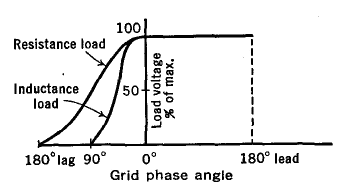| Basic Radio is a free introductory textbook on electronics based on tubes. See the editorial for more information.... |

|

Home  Basic Circuits Basic Circuits  Operation of Gas-Filled Tubes Operation of Gas-Filled Tubes  Phase Control Phase Control |
||||||






|
||||||
|
Phase ControlAuthor: J.B. Hoag We next consider an operating condition much used in practice with gas-filled triodes. We propose, first, to apply a small alternating voltage to the grid and a large alternating voltage to the plate by means of two transformers as in Fig. 19 C. Now, by some hook or crook, we propose to vary the relative phase of these two voltages, that is, the relative time at which they reach their peak values.
Figure 19 G shows the average value of the plate current or load voltage for various phases of the grid voltage (with respect to the phase of the plate voltage), in the case where the load in the plate circuit is resistive, and where it is inductive.
|
||||||
Home  Basic Circuits Basic Circuits  Operation of Gas-Filled Tubes Operation of Gas-Filled Tubes  Phase Control Phase Control |
||||||
Last Update: 2009-11-01



